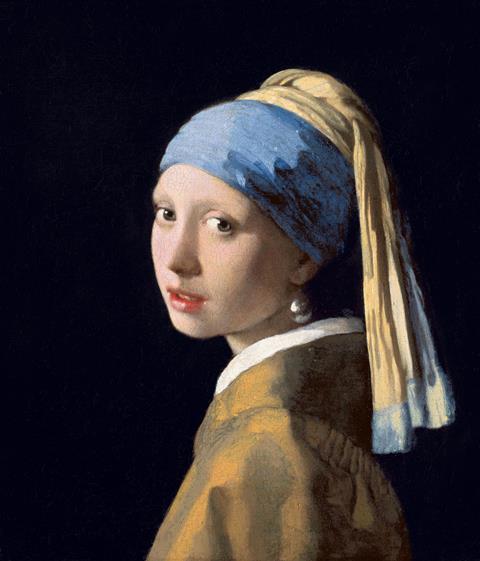Woman Alive deputy editor, Jemimah Wright explores a fresh theory about Vermeer’s Girl with a Pearl Earring — could this enigmatic masterpiece actually depict Mary Magdalene at the moment she recognises the risen Christ?

The painting Girl with a Pearl Earring, by Johannes Vermeer, is one of those images that seems to seep into your life. Tracy Chevalier’s novel Girl with a Pearl Earring made the mysterious maid famous, the 2003 film starring Scarlett Johansson gave her face to millions.
As a teenager I had a small print of the painting in my bedroom. I would glance at her image in yellow and blue turban with the glowing pearl, trying to guess what she was thinking. So when I read the recent Times article, “How I unmasked the real Girl with a Pearl Earring,” by Andrew Graham-Dixon, claiming new archival research reveals that Vermeer did not simply paint a “tronie” or generic beauty but rather his patrons’ daughter Magdalena van Ruijven, posing as Mary Magdalene, I was intrigued.
READ MORE: ‘I have been praying the rosary in Rome for the Pope’s recovery and I will continue to pray for him as I play Mary Magdalene at The Passion of Jesus in Trafalgar square this Easter’
According to Graham-Dixon, Vermeer’s chief patrons, Maria de Knuijt and Pieter van Ruijven, lived in a house called the Golden Eagle in Delft. They were devout Remonstrants, with ties to the more radical Christian group called the Collegiants. (The Remonstrants and the Collegiants were both religious movements in the Netherlands during the 16th and 17th centuries, arising in the context of the Protestant Reformation, but they had distinct beliefs and approaches.)
Their daughter, Magdalena van Ruijven, born October 1655, would have been about twelve in autumn 1667, which is roughly when Graham-Dixon believes Girl with a Pearl Earring to have been painted (or slightly later, 1667–68). Magdalena was likely initiated into the Collegiant faith at that age; perhaps the painting marked that rite of passage.
READ MORE: March Book Club - Unmaking Mary: Shattering the myth of perfect motherhood by Chine McDonald
More strikingly, the painting is argued not to be a mere portrait but an imaginary (biblical) representation of Mary Magdalene at the moment in John’s Gospel when she turns back and recognizes the resurrected Christ
More strikingly, the painting is argued not to be a mere portrait but an imaginary (biblical) representation of Mary Magdalene at the moment in John’s Gospel when she turns back and recognizes the resurrected Christ, “She turned herself back, and saw Jesus standing … She, supposing him to be the gardener … Jesus saith unto her, Mary.” The huge pearl earring becomes symbolic: not just ornament, but a reflection of the soul, divine recognition, seeing Jesus, expressing awe, wonder, perhaps even tears.
From a Christian perspective, this theory has some compelling aspects: The idea that the painting captures Mary Magdalene’s moment of recognition, turning back, is poetic and matches the emotional intensity people sense when they view the painting. Graham-Dixon reads that into the facial expression, the eyes, the light, the tearfulness, the oversized pearl as something more than literal, as emblematic.
READ MORE: We launched the first faith-focused art awards because creativity reflects a core part of God’s nature
While Graham-Dixon has identified documents about the patrons, their faith, the house, etc., I did not see in the reporting a document explicitly stating “this painting is Mary Magdalene” or that Vermeer intended the sitter to represent Mary Magdalene. Interpretation is being made from several suggestive clues, but not a firm declaration. The conventional view among many art historians is that Girl with a Pearl Earring is a tronie, a study of character, costume, light, and expression, not necessarily a portrait of a known individual or a biblical figure. The tronie tradition allows for a more free, imaginative use of features and costume. That doesn’t rule out symbolic meaning, but it makes definite identifications tricky.
Mary Magdalene is a rich figure in Scripture, one of the first to recognize the risen Christ, an expression of hope, devotion, redemption. If Vermeer’s painting is indeed intended to evoke that moment, then the artwork becomes something like a visual meditation: an invitation to consider resurrection, recognition, identity.
Even if the claim turns out to be overstated, the theory reminds us to look at art not merely as decoration, but as something that can speak to our faith, our hearts. Either way, the painting continues to captivate because it balances mystery and presence. We cannot fully know the sitter, but in that unknown face we see something of the sacred.




































No comments yet